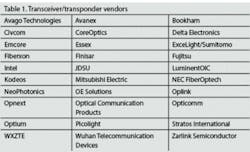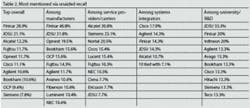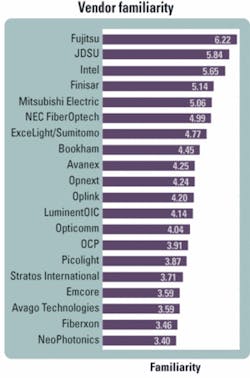Readers rank transceiver/transponder vendors
by Stephen Hardy
Last month in this space, we revealed some of the purchase criteria engineers and others use when they buy transceivers and transponders, based on results of a reader study Lightwave conducted early this year. (See “Readers Reveal Transceiver/Transponder Purchase Factors,” Lightwave, September 2007, page 39.) After we quizzed our subscriber group about the factors that go into evaluating technology and suppliers, we asked them to give us their opinions of 30 transceiver/transponder vendors (see Table 1), including which ones they consider leaders, which ones they’re buying from now, and how familiar they are with each vendor’s product line. While the first two topics didn’t elicit many surprises, the last one did. Despite the best efforts of the vendors, their sales people, their public relations firms, and, yes, magazines such as this one, transceiver/transponder buyers indicate they’re not very familiar with what each vendor-regardless of market share-has to offer.
As we described last month, the Lightwave staff hired market and media research company Advantage Business Research (ABR; www.advantageresearch.com) to help us survey a slice of our readership this past February. ABR e‑mailed a questionnaire to approximately 3,000 readers who had identified themselves as purchasers of transceivers and transponders when they subscribed to the magazine. The subsequent response base of just under 10% provided us with results with a margin of error no greater than ±5.8 percentage points at a confidence rate of 95%, ABR told us.
The respondents came from around the world (see last month’s report for the breakdown) and they work in a variety of areas: systems/subsystems design and development (39.5%), carriers/service provision (21.3%), systems integration (17.8%), and university/R&D (11.2%).
The respondent demographics are important to remember in evaluating our respondents’ opinions about the 30 transceiver/transponder suppliers. For example, demographics are particularly significant when it comes to interpreting the results of our unaided recall of module vendors. Most equipment manufacturers deal directly with the transceiver/transponder vendors; however, service providers often receive modules from the equipment makers.
This disparity explains the aggregate results when we asked our respondents to tell us which companies came to mind when they thought of transceiver/transponder makers; they could offer a maximum of five names. The top five slots were filled by Finisar (mentioned by 28.9% of respondents), JDSU (21.1%), Alcatel (12.2%; the survey was conducted before the merger with Lucent), Fujitsu and Opnext (tied at 11.7%), followed closely by Cisco (11.1%). In fact, as Table 2 highlights, three of the 10 companies that received the most mentions are systems companies, while Fujitsu has both systems and module divisions, which undoubtedly gave it visibility in multiple niches.
Separating the results by the market area in which the respondents operate underscores the importance of this demographic. As Table 2 illustrates, the expected suppliers of transceivers/transponders dominated the list equipment manufacturers generated, while systems houses topped the vendor list service providers generated. It is also interesting to note how many of our respondents continue to think of Avago Technologies as Agilent; in our overall count, an additional 7.2% of respondents mentioned Avago by name.
We next provided our readers with the list of 30 transceiver/transponder vendors highlighted in Table 1 and asked how familiar they were with the product lines of each company on a scale of 1 to 10, with the former representing “Not at all familiar” and the latter “Extremely familiar.” Perhaps the fact that Finisar topped the unaided recall list with a score of less than 30% should have prepared us for the responses to this question, but the results surprised us nevertheless: No company-not even major vendors such as Finisar and JDSU-garnered a mean score higher than 6.22. In fact only five companies-Finisar, Fujitsu, Intel, JDSU, and Mitsubishi Electric-exceeded the very middling figure of 5 (see figure).
Clearly, it appears our respondents don’t believe they know their potential suppliers very well. In defense of our respondents (and, perhaps, the suppliers’ marketing departments), the current slate of transceiver/transponder options is both broad and deep, between the various ITU and IEEE standards as well as the multitude of multisource agreements (MSAs). Keeping up with which suppliers support what standards and MSAs would require quite a database. Also, market research shows that different suppliers dominate different market niches, so while a respondent might know the leading players in his/her area, that doesn’t mean they would be familiar with what those vendors offer in other areas.
Despite perhaps not being familiar with all their options, our readers do buy transceivers and transponders. And they have definite opinions about the companies that supply them.
To establish which vendors were considered leaders among our respondents, we began by asking them to tell us which companies had supplied them with transceivers and transponders in 2006. All 30 companies had clients within our respondent pool, with JDSU (36.5%), Fujitsu (27%), Finisar (26.4%), NEC FiberOptech (20.2%), and Intel (18%) the most frequently mentioned.
We then asked each respondent who had rated their familiarity with a company’s product line at 6 or higher to tell us whether they viewed that supplier as a “top tier,” “middle tier,” or “bottom tier” company based on such factors as reputation, performance/reliability, and product value relative to price. Six companies received “top tier” status from more than 50% of the respondents who rated them: Fujitsu (64.5%), JDSU (63.8%), Intel (62.6%), Finisar (60.8%), Mitsubishi Electric (60.6%), and NEC FiberOptech (53%). The other 24 suppliers fall firmly in the “middle tier” category; no company was deemed “bottom tier” by as much as 25% of its evaluators.
Finally, we asked our readers which module vendors occupied their short list for 2007 purchases. Not surprisingly, the vendors who were the top suppliers for 2006 and who also enjoy “top tier” evaluations did well, with Fujitsu (38.7%), JDSU (37.1%), Intel (29%), Finisar (28.5%), NEC FiberOptech (25.3%), and Mitsubishi Electric (19.4%) again heading the list.
However, several companies appear ready to challenge these six. Opnext (17.7%), ExceLight/Sumitomo (15.6%), and Bookham (15.1%) were named by more than 15% of our readers as primed for business, while Avago, Avanex, Fiberxon and LuminentOIC (since combined to create Source Photonics), Oplink, Optical Communications Products (which Oplink recently acquired), and Picolight (now part of JDSU) each held a place on the short lists of at least 10% of our respondents. Given the consolidation in the market, next year’s survey should pinpoint which of these companies are indeed rising stars.
Stephen Hardy is the editorial director and associate publisher of Lightwave.



